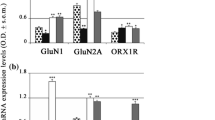Abstract
NCAM is known to play an important role in the regulation of neural development, functioning, and regeneration. To investigate the role of NCAM in a pathological state (experimental ischemia), we used a synthetic peptide, P2, mimicking physiological homophilic binding of NCAM. The viability, morphological and ultrastructural features, and metabolic activity of the cells in organotypic hippocampal cultures were estimated. Our data showed that pretreatment with P2 increased the cell viability and exerted a protective effect preventing changes of hippocampal cultures induced by ischemia. Thus, P2 can be supposed to be a promising agent for the further development of drugs for the treatment of neurodegenerative disorders.
Similar content being viewed by others
REFERENCES
V. Soroka, D. Kiryushko, V. Novitskaya, et al., “Induction of neuronal differentiation by a peptide corresponding to the homophilic binding site of the second Ig module of NCAM,” J. Biol. Chem., in print.
L. Rønn, M. Olsen, S. Ostergaard, et al., “Identification of a neuritogenic ligand of the neural cell adhesion molecule using a combinatorial library of synthetic peptides,” Nat. Biotechnol., 17,No. 10, 1000–1005 (1999).
M. Iwai, T. Hayashi, W. Zhang, et al., “Induction of highly polysialylated neural cell adhesion molecule (PSA-NCAM) in postischemic gerbil hippocampus mainly dissociated with neural stem cell proliferation,” Brain Res., 902,No. 2, 288–293 (2001).
L. Stoppini, P.-A. Buchs, and D. Muller, “A simple method for organotypic cultures of nervous tissue,” J. Neurosci. Methods, 37, 173–182 (1991).
J. Laake, F.-M. Haug, T. Wieloch, and O. Ottersen, “A simple in vitro model of ischemia based on hippocampal slice cultures and propidium iodide fluorescence,” Brain Res. Prot., 4, 173–184 (1999).
C. Connelly, L. Chen, and S. Colquhoun, “Metabolic activity of cultured rat brainstem, hippocampal and spinal cord slices,” J. Neurosci. Methods, 99, 1–7 (2000).
N. Marshal, C. Goodwin, and S. Holt, “A critical assessment of the use of microculture tetrazolium assays to measure cell growth and function,” Growth Regulat., 5, 69–84 (1995).
M. Bernaudin, A. Nouvelot, E. MacKenzia, and E. Petit, “Selective neuronal vulnerability and specific glial reactions in hippocampal and neocortical organotypic cultures submitted to ischemia,” Exp. Neurol., 150, 30–39 (1998).
C. Pena and G. Pilar, “Early morphologic alterations in trophically deprived neuronal death in vitro occur without alterations in cytoplasmic Ca(2+),” J. Comp. Neurol., 424,No. 3, 377–396 (2000).
S. Kubo, O. Kitamura, Y. Orihara, et al., “Immunohistochemical diagnosis and significance of forensic neuropathological changes,” J. Med. Invest., 44,Nos. 3/4, 109–119 (1998).
Author information
Authors and Affiliations
Corresponding author
Rights and permissions
About this article
Cite this article
Skibo, G.G., Lushnikova, L., Voronin, K. et al. Effect of a Peptide Mimetic of NCAM on the Structure and Metabolic Activity of Organotypic Hippocampal Cultures during Induced Ischemia. Neurophysiology 34, 233–236 (2002). https://doi.org/10.1023/A:1020788308226
Issue Date:
DOI: https://doi.org/10.1023/A:1020788308226



